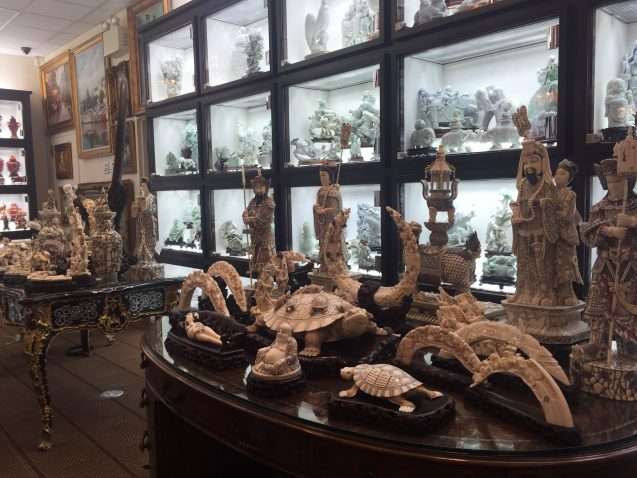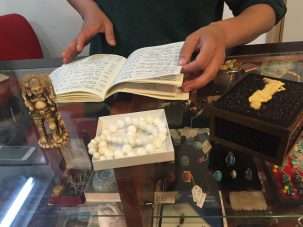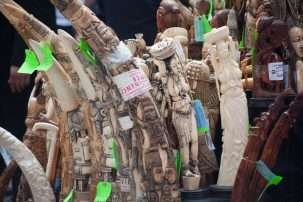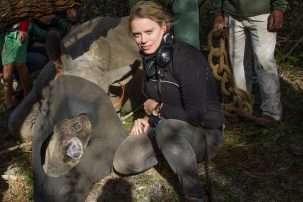Student writing project exposes NYC's illegal ivory trade

In spring 2016, student Wendy Hapgood walked around midtown Manhattan, visiting antique stores advertising mammoth ivory for sale that she found on Google maps. "Mammoth tusk is so interesting," she explained, "A piece of ancient past, a long extinct mammal, dug up in the tundra in Russia, sent to China for carving, then finding its way here."
With her outgoing personality and interest in both art and conservation, she found it easy to engage shopkeepers in conversation as a potential buyer. What could they tell her about the carved "netsuke" pieces? What kind of buyers purchase these large tusks? Where will the gallery ship to? It wasn't until she got to Metropolitan Fine Arts & Antiques that she suspected anything was amiss. A shopkeeper, wary of her motives, prevented her from entering the back room, which she could see was filled wall-to-wall with what looked like elephant ivory.
"That's when I knew I had a story," she said. "I knew I needed to go back."
Hapgood, a student in the Master of Science in Sustainability Management program, was looking for a term project for her Writing about Science for International Media class. Designed to help scientists communicate their work more effectively to the public, students enrolled in the course are encouraged to select a journalism project on a topic that they care about. Knowing that Hapgood had recently co-founded an anti-poaching organization, the Wild Tomorrow Fund, professor Claudia Dreifus encouraged her to investigate the possible sale of illegal elephant ivory in Manhattan.

Dreifus, who writes an interview column for the New York Times, suspected that the elephant tusks and rhinoceros horns lining shop windows were just plastic replicas that they were selling to tourists, especially since New York's ivory laws had recently been strengthened. At the time, Hapgood agreed. "When I started the project, I was super worried that I wouldn't have a story to write," she said, "because I didn't really think there would be ivory just openly for sale in Manhattan."
New York has one of the largest markets for ivory in the United States, leading legislators to enact one of the strictest bans in the country in 2014. The New York ban further restricted the trade of elephant ivory and rhinoceros horn, with limited exceptions, and increased the criminal and civil penalties for violations. It also restricted the trade of mammoth fossil ivory, which had not been included in earlier versions of the ban. (An international treaty, CITES, bans most trade in ivory harvested after 1976.)
Since it is difficult to distinguish between mammoth and elephant ivory, some vendors were attempting to sell recently poached elephant ivory by passing it off as mammoth. To curb this practice, mammoth was included in the updated legislation, and vendors were given a two-year grace period to revise their inventories; as Hapgood discovered, some took advantage of the window to continue trafficking in elephant ivory as well.
Hapgood returned to Metropolitan Fine Arts & Antiques a month later with her boyfriend, who was also shocked to see how much ivory they seemed to have. This time, the shopkeeper escorted them to the back room, where he attempted to sell them a "starter piece" of what they suspected was elephant ivory. "They gave these stores a grace period, a bit of time to adjust to the law," Hapgood explained. "But they were lying to me and saying, 'Oh, this is mammoth.' It's too hard for the consumer to tell the difference."

Considering the potential value of the ivory, she was concerned about putting herself at risk by reporting the store and publishing her project. But she decided to call the Department of Environmental Conservation hotline anyway, later meeting with investigators in person. Together, they discussed what she'd found while reviewing the laws and how to distinguish between different types of tusks.
As it turns out, Metropolitan Fine Arts & Antiques was already on the department's radar. Two undercover investigators posing as buyers had purchased a statuette allegedly of mammoth tusk; upon testing the piece at the American Museum of Natural History, it was discovered to be made of African elephant ivory. Following up with a search warrant, the investigators found $4.5 million in illegal ivory at the shop, making it the largest bust in New York State history. The salesperson and owners of the shop, Victor Zilberman and brothers Irving and Samuel Morano, were indicted in September 2016, and the case is pending as of this writing.
This month, the DEC announced a conviction in another ivory bust at a Manhattan antique shop, the Landmark Gallery, where environmental conservation officers recovered $250,000 in elephant ivory. As part of the plea, the shop agreed to make a $50,000 donation to the Wild Tomorrow Fund.
"What Wendy did is what I hope all the people in the course do, which is go out and find how the world applies to their science, and observe it and investigate it and learn about it and write about it, and she did that. And she did uncover real violations," Dreifus said. "That they'll be able to use some of this money that the merchants have been fined to prevent more poaching and more wildlife deaths, that's wonderful."

Coordinating with rangers on the ground in South Africa, Hapgood and her co-founders started the Wild Tomorrow Fund by raising money for needed items, including updated uniforms, new tires for field vehicles, and supplies for anti-poaching dogs. They've since been able to expand into habitat conservation and education, purchasing land to close the gap between existing reserves and creating a poaching crime scene training program for rangers working along the border between South Africa and Mozambique, starting in May 2017. "It's great for international cooperation, for the rangers who share a border to work together," said Hapgood.
With this donation, they hope to expand further, helping to finance an anti-poaching rapid response vehicle to allow rangers to quickly address incursions, and dehorning 18 critically endangered black rhinos. With only 5,000 black rhinos left in the wild and horns fetching as much as $100,000 per kilogram on the black market, disincentivizing poachers on the supply side can be an effective short-term solution. Hapgood wrote about the dehorning process here in 2016.
However, in the longer term, she says, demand reduction is vital. Despite a crack-down on poaching on the ground, a recent study co-authored by Lamont-Doherty Earth Observatory geochemist Kevin Uno found that the vast majority of ivory coming out of Africa has been recently harvested. Hapgood believes that New York's system, by combining tough laws with the resources needed to investigate violations and hold offenders accountable, while benefiting organizations working on the front lines of anti-poaching, will help shut down the market for ivory here and have a real impact on anti-poaching efforts in Africa.
"I love connecting New York with anti-poachers on the ground," she says. "We started this organization because it's so easy for New Yorkers to help."
Provided by Earth Institute, Columbia University
This story is republished courtesy of Earth Institute, Columbia University http://blogs.ei.columbia.edu.




















